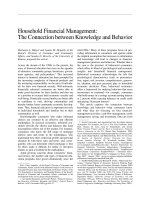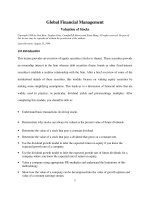Financial management paramiasivan
Bạn đang xem bản rút gọn của tài liệu. Xem và tải ngay bản đầy đủ của tài liệu tại đây (11.94 MB, 284 trang )
This page
intentionally left
blank
Copyright © 2009, New Age International (P) Ltd., Publishers
Published by New Age International (P) Ltd., Publishers
All rights reserved.
No part of this ebook may be reproduced in any form, by photostat, microfilm,
xerography, or any other means, or incorporated into any information retrieval
system, electronic or mechanical, without the written permission of the publisher.
All inquiries should be emailed to
ISBN (13) : 978-81-224-2716-5
PUBLISHING FOR ONE WORLD
NEW AGE INTERNATIONAL (P) LIMITED, PUBLISHERS
4835/24, Ansari Road, Daryaganj, New Delhi - 110002
Visit us at www.newagepublishers.com
Preface
Financial Management is an essential part of the economic and non economic activities
which leads to decide the efficient procurement and utilization of finance with profitable
manner. In the olden days the subject Financial Management was a part of accountancy
with the traditional approaches. Now a days it has been enlarged with innovative and
multi dimensional functions in the field of business with the effect of industrialization,
Financial Management has become a vital part of the business concern and they are
concentrating more in the field of Financial Management. Financial Management also
developed as corporate finance, business finance, financial economics, financial mathematics
and financial engineering. Understanding the basic concept about the financial management
becomes an essential part for the students of economics, commerce and management.
This book provides detailed information about the finance and finance related area
with simple language and the concepts are explained with easy examples. This book is also
prepared based on the B.Com., B.B.A., B.B.M., M.Com., and M.B.A. syllabus of various
universities for the benefits of the students.
AUTHORS
This page
intentionally left
blank
Contents
Preface
CHAPTER - 1 INTRODUCTION TO FINANCIAL MANAGEMENT
Introduction
Meaning of Finance
Definition of Finance
Definition of Business Finance
Types of Finance
Definition of Financial Management
Scope of Financial Management
Objectives of Financial Management
• Profit maximization
• Favourable arguments for profit maximization
• Unfavorable arguments for profit maximization
• Drawbacks of profit maximization
• Wealth maximization
• Favourable arguments for wealth maximization
• Unfavourable arguments for wealth maximization
Approaches to Financial Management
• Traditional approach
Functions of Finance Manager
Importance of Financial Management
• Financial planning
• Acquisition of funds
• Proper use of funds
• Financial decision
• Improve profitability
(v)
1–10
1
1
1
2
2
3
4
5
5
6
6
6
6
7
7
7
8
8
9
9
9
10
10
10
Contents
• Increase the value of the firm
• Promoting savings
Model Questions
CHAPTER - 2 FINANCIAL STATEMENT ANALYSIS
Introduction
Meaning and Definition
• Income statement
• Position statement
• Statement of changes in owners equity
• Statement of changes in financial position
Types of Financial Statement Analysis
Techniques of Financial Statement Analysis
• Comparative statement analysis
• Comparative balance-sheet analysis
• Comparative profit and loss account analysis
• Trend analysis
• Common size analysis
Funds Flow Statement
Cash Flow Statement
• Difference between funds flow and cash flow statement
Ratio Analysis
• Liquidity ratio
• Activity ratio
• Solvency ratio
• Profitability ratio
Model Questions
CHAPTER - 3 SOURCES OF FINANCING
Introduction
• Long-term financial requirements or Fixed capital requirement
• Short-term financial requirements or Working capital requirement
Sources of Finance
Security Finance
• Characters of security finance
• Types of security finance
• Ownership securities
Equity Shares
• Features of equity shares
• Advantages of equity shares
• Disadvantages of equity shares
Preference Shares
• Irredeemable preference shares
10
10
10
11–24
11
11
12
12
12
12
13
14
15
15
16
17
17
18
19
19
20
21
21
22
22
24
25–39
25
25
25
26
28
28
28
28
28
28
29
30
30
31
Contents
• Participating preference shares
• Non-participating preference shares
• Convertible preference shares
• Non-convertible preference shares
• Features of preference shares
• Advantages of preference shares
• Disadvantages of preference shares
Deferred Shares
No Par Shares
Creditorship securities
• Debentures
• Types of debentures
• Features of debentures
• Advantages of debenture
• Disadvantages of debenture
Internal Finance
• Depreciation funds
• Retained earnings
• Advantages of retained earnings
• Disadvantages of retained earnings
Loan Financing
• Financial institutions
• Commercial banks
• Short-term loans
• Development banks
Model Questions
CHAPTER - 4 CAPITALIZATION
Introduction
Meaning of Capital
• Fixed capital
• Definition of fixed capital
• Character of fixed capital
• Working capital
Capitalization
• Meaning of capitalization
• Definition of capitalization
Types of Capitalization
• Over capitalization
• Causes of over capitalization
• Effects of over capitalization
• Remedies for over capitalization
• Under capitalization
• Causes of under capitalization
31
31
31
31
31
31
32
32
32
33
33
33
34
34
34
35
35
35
36
36
37
37
37
38
38
38
41–45
41
41
41
41
42
42
42
42
43
43
43
43
44
44
44
44
Contents
•
•
•
•
Effects of under capitalization
Remedies of under capitalization
Watered capitalization
Causes of watered capital
CHAPTER - 5 CAPITAL STRUCTURE
Introduction
• Meaning of capital structure
• Definition of capital structure
Financial Structure
Optimum Capital Structure
• Objectives of capital structure
• Forms of capital structure
Factors Determining Capital Structure
• Leverage
• Cost of capital
Capital Structure Theories
• Traditional approach
• Assumptions
• Comments
• Net Income (NI) approach
• Net Operating Income (NOI) approach
• Modigliani and Miller approach
Model Questions
CHAPTER - 6 COST OF CAPITAL
Introduction 65
• Meaning of cost of capital
• Definitions
• Assumption of cost of capital
Classification of Cost of Capital
• Explicit and implicit cost
• Average and marginal cost
• Historical and future cost
• Specific and combine cost
Importance of Cost of Capital
• Importance to capital budgeting decision
• Importance to structure decision
• Importance to evolution of financial performance
• Importance to other financial decisions
Computation of Cost of Capital
• Measurement of cost of capital
• Cost of equity
45
45
45
45
47–64
47
47
47
48
49
49
49
50
50
50
50
51
51
53
53
55
58
64
65–82
65
65
66
66
66
67
67
67
67
67
67
68
68
68
68
68
Contents
• Dividend price approach
• Dividend price plus growth approach
• Earning price approach
• Realized yield approach
• Cost of debt
• Debt issued at par
• Debt issued at premium or discount
• Cost of perpetual debt and redeemable debt
• Cost of preference share capital
• Cost of retained earnings
• Measurement of overall cost of capital
Model Questions
CHAPTER - 7 LEVERAGE
Introduction
• Meaning of leverage
• Definition of leverage
• Types of leverage
Operating Leverage
• Degree of operating leverage
• Uses of operating leverage
Financial Leverage
• Degree of financial leverage
• Alternative definition of financial leverage
• Uses of financial leverage
Distinguish Between Operating Leverage and Financial Leverage
EBIT - EPS Break Even Chart for Three Different Financing Alternatives
Combined Leverage
• Degree of combined leverage
Working Capital Leverage
Model Questions
CHAPTER - 8 DIVIDEND DECISION
Introduction
• Meaning of dividend
Types of Dividend/Form of Dividend
• Cash dividend
• Stock dividend
• Bond dividend
• Property dividend
Dividend Decision
Irrelevance of Dividend
68
69
70
71
72
72
72
73
74
76
77
80
83–98
83
83
83
83
84
84
85
86
86
87
87
89
89
90
90
93
96
99–117
99
99
99
100
100
100
100
100
101
Contents
Modigliani and Miller’s Approach
Relevance of Dividend
• Walter’s model
• Gordon’s model
Factors Determining Dividend Policy
• Profitable position of the firm
• Uncertainty of future income
• Legal constrains
• Liquidity position
• Sources of finance
• Growth rate of the firm
• Tax policy
• Capital market conditions
Types of Dividend Policy
• Regular dividend policy
• Stable dividend policy
• Irregular dividend policy
• No dividend policy
Model Questions
CHAPTER - 9 CAPITAL BUDGETING
Introduction
• Definitions
• Need and importance of capital budgeting
Capital Budgeting Process
Kinds of Capital Budgeting Decisions
Methods of Capital Budgeting of Evaluation
• Pay-back period
• Un even cash inflows
• Post pay-back profitability method
• Accounting rate of return or Average rate of return
• Net present value
• Internal rate of return
• Excess present value index
• Capital rationing
Risk and Uncertainly in Capital Budgeting
• Risk adjusted cut off rate
• Certainly equivalent method
• Sensitivity technique
• Probability technique
• Standard deviation method
• Co-efficient of variation method
• Decision tree analysis
101
107
107
111
115
115
115
115
115
115
115
115
115
116
116
116
116
116
116
119–147
119
119
120
120
122
122
122
124
124
126
128
131
135
135
136
136
137
138
139
140
142
142
Contents
• Construction of decision tree
Model Questions
CHAPTER - 10 WORKING CAPITAL
Introduction
Meaning of Working Capital
• Definitions
Concept of Working Capital
• Gross working capital
• Net working capital
• Component of working capital
Types of Working Capital
• Permanent working capital
• Temporary working capital
• Semi variable working capital
Needs of Working Capital
• Working capital position/Balanced working capital position
Factors Determining Working Capital Requirements
Computation (or Estimation) of Working Capital
Working Capital Management Policy
Sources of Working Capital
• Determining the finance mix
— Hedging approach
— Conservative approach
— Aggressive approach
Working Capital and Banking Committee
Model Questions
CHAPTER - 11 WORKING CAPITAL MANAGEMENT
Introduction
• Meaning
• Definition
Inventory Management
Introduction
• Meaning
• Kinds of inventories
• Objectives of inventory management
• Techniques of inventory management
• Stock level
• Minimum level
• Re-order level
• Maximum level
• Danger level
142
144
149–163
149
149
150
150
151
151
151
152
152
153
153
154
154
155
156
159
160
161
161
162
162
163
163
165–197
165
165
165
165
166
166
166
166
167
167
168
168
168
168
Contents
• Average stock level
• Lead time
• Safety stock
• Economic order quantity (EOQ)
Techniques Based on the Classification of Inventories
• A-B-C analysis
• Aging schedule of inventories
• VED analysis
• HML analysis
Techniques on the Basis of Records
• Valuation of inventories
Cash Management
• Motives for holding cash
• Cash management techniques
• Speedy cash collections
— Prompt payment by customers
— Early conversion of payments into cash
— Concentration banking
— Lock box system
• Slowing disbursement
• Cash management models
Receivable Management
• Collection cost
• Capital cost
• Administrative cost
• Default cost
• Factors considering the receivable size
Model Questions
CHAPTER - 12 SPECIAL FINANCING
Lease Financing
• Definition of leasing
• Elements of leasing
• Term of lease
• Lease rental
• Type of leasing
• Advantages of leasing
• Leasing finance institutions in India
• Leasing by development institutions
• Leasing by specialized institutions
• Private sector leasing company
• Private sector financial company
Venture Capital
168
168
169
169
171
171
171
172
172
172
172
173
173
176
176
176
176
176
176
177
177
179
179
179
179
179
179
194
199–224
199
199
200
200
200
200
202
203
203
203
204
204
204
Contents
• Introduction
• Meaning of venture capital
• Definition of venture capital
• Features of venture capital
• Venture capital in India
Factoring
• Myths on factoring
• History of the early factoring in Roman
• Factoring in United States
• Factoring in India
• Modus of operations
• Why factoring?
• Mechanics of factoring
• Types of factoring
Foreign Direct Investment
• FDI in India
• Through private placements or preferential allotments
• A comparative study between India and China
• Foreign Institutional Investors (FIIS)
• SEBI and FIIs
Merchant Banking
• Introduction
• Meaning
• Merchant banking in India
• Classification of merchant banking
• Functions of merchant banking
• Merchant banking organizations
Credit Rating
• Introduction
• Meaning of credit rating
• Objectives of credit rating
• Credit rating in India
• Operational performance of credit rating business in India
• Basis for credit rating
• Credit Rating Information Service of India Limited (CRISIL)
• Credit rating symbols of credit rating information service of India limited
• Operational result of credit rating information service of India limited
• Investment Information and Credit Rating Agency of India limited (ICRA)
• Credit rating symbols of investment information and credit rating agency of
India limited
• Operational result of ICRA
• Credit Analysis and Research Limited (CARE)
• Credit rating symbols of credit analysis and research limited
204
204
204
205
205
206
206
207
207
207
208
208
209
210
210
211
211
212
212
212
214
214
214
214
214
215
215
216
216
216
216
216
217
217
217
217
218
218
218
219
219
219
Contents
• Operational result of credit analysis and research limited
Mutual Funds
• Introduction
• Origin of mutual funds
• Structure of mutual fund in India
• Meaning of mutual fund
• Advantages of mutual funds
• Public sector mutual fund
• Private sector mutual fund
• Open ended mutual fund
• Closed ended mutual fund
• Growth generated mutual fund
• Income generated mutual fund
• Balanced mutual fund
• Domestic mutual fund
• Global mutual fund
• Regional mutual fund
• Sector mutual fund
• Top ten mutual fund
Model Questions
CHAPTER - 13 FINANCIAL SYSTEM
Introduction
Financial System in India
• Financial institutions
• Banking institutions
• Commercial banks
• Scheduled commercial banks
• Nationalised banks
• State Bank of India(SBI)
• Growth and structure of commercial banks in India
• Private sectors banks
• New banks in private sectors
• Foreign banks in India
• Non-banking institutions
• Non-banking financial institutions
Industrial Finance Corporation of India (IFCI)
• Origin
• Capital
• Objectives
• Functions
• Management
• Subsidies of industrial finance corporation of India
• Working result
219
220
220
220
220
221
221
222
222
222
223
223
223
223
223
223
223
223
223
224
225–264
225
225
226
226
226
226
227
228
228
229
229
230
231
231
231
231
232
232
232
232
232
233
Contents
Industrial Credit and Investment Corporation of India (ICICI)
• Origin
• Capital
• Objective
• Functions
• Management
Subsidies of industrial credit and investment corporation of India
• Working result
Industrial Development Bank of India (IDBI)
• Origin
• Capital
• Objectives
• Functions
• Management
• Working result
Industrial Reconstruction Bank of India (IRBI)
• Origin
• Capital
• Objectives
• Functions
• Management
• Working result
State Finance Corporation (SFC)
• Origin
• Capital
• Objectives
• Functions
• Management
State Finance Corporation in Tamil Nadu
Export Import Bank (Exim Bank)
• Origin
• Capital
• Objectives
• Functions
• Management
• Working result
National Bank for Agricultural and Rural Development
• Origin
• Capital
• Objectives
• Functions
• Management
• Working result
Specialized Financial Institutions
233
233
233
233
233
233
234
234
234
234
234
234
234
235
235
235
235
235
236
236
236
236
236
236
237
237
237
237
237
237
237
237
237
238
238
238
238
238
238
238
239
239
239
239
Contents
Insurance Sector in India
• Some of the private sector life insurance corporation
Life Insurance Corporation of India
• Role of LIC
General Insurance Companies
Unit Trust of India
• Origin
• Capital
• Objectives
• Functions
• Management
• Subsidiaries of Unit Trust of India
• Schemes of Unit Trust of India
• Working result of Unit Trust of India
Non-banking Non-financial Institutions
Financial Markets
• Capital market
• MIBOR and MIBID
• Share market
• Primary market
• Secondary market
• Methods of raising capital
• Public issue
• Right Issue
• Private placement
• Group A and group B shares
Securities and Exchange Board of India (SEBI)
• Functions
• Trading procedure at stock exchanges
• Recent trends in capital market
Share Market Terminology
• Main share price index in famous share market of the world
• Name of share price indices changed
• Money market
• Discount and Finance House of India Ltd. (DFHI)
• Commercial Paper (CP)
• Money Market Mutual Funds (MMMFs)
• Venture Capital Funds (VCFs)
• Financial services
• Fund based financial services
• Fee based financial services
• Non-banking Finance Companies (NBFC)
Model Questions
240
241
241
241
242
243
243
243
243
243
244
244
244
244
245
245
246
248
248
248
249
250
251
251
251
252
252
252
253
253
255
257
257
257
260
260
261
262
262
262
262
263
264
INTRODUCTION
Business concern needs finance to meet their requirements in the economic world. Any
kind of business activity depends on the finance. Hence, it is called as lifeblood of business
organization. Whether the business concerns are big or small, they need finance to fulfil
their business activities.
In the modern world, all the activities are concerned with the economic activities and
very particular to earning profit through any venture or activities. The entire business
activities are directly related with making profit. (According to the economics concept of
factors of production, rent given to landlord, wage given to labour, interest given to capital
and profit given to shareholders or proprietors), a business concern needs finance to meet
all the requirements. Hence finance may be called as capital, investment, fund etc., but
each term is having different meanings and unique characters. Increasing the profit is the
main aim of any kind of economic activity.
MEANING OF FINANCE
Finance may be defined as the art and science of managing money. It includes financial
service and financial instruments. Finance also is referred as the provision of money at the
time when it is needed. Finance function is the procurement of funds and their effective
utilization in business concerns.
The concept of finance includes capital, funds, money, and amount. But each word is
having unique meaning. Studying and understanding the concept of finance become an
important part of the business concern.
DEFINITION OF FINANCE
According to Khan and Jain, “Finance is the art and science of managing money”.
Financial Management
2
According to Oxford dictionary, the word ‘finance’ connotes ‘management of money’.
Webster’s Ninth New Collegiate Dictionary defines finance as “the Science on study
of the management of funds’ and the management of fund as the system that includes the
circulation of money, the granting of credit, the making of investments, and the provision
of banking facilities.
DEFINITION OF BUSINESS FINANCE
According to the Wheeler, “Business finance is that business activity which concerns
with the acquisition and conversation of capital funds in meeting financial needs and overall
objectives of a business enterprise”.
According to the Guthumann and Dougall, “Business finance can broadly be defined
as the activity concerned with planning, raising, controlling, administering of the funds
used in the business”.
In the words of Parhter and Wert, “Business finance deals primarily with raising,
administering and disbursing funds by privately owned business units operating in nonfinancial fields of industry”.
Corporate finance is concerned with budgeting, financial forecasting, cash
management, credit administration, investment analysis and fund procurement of the
business concern and the business concern needs to adopt modern technology and
application suitable to the global environment.
According to the Encyclopedia of Social Sciences, “Corporation finance deals with
the financial problems of corporate enterprises. These problems include the financial aspects
of the promotion of new enterprises and their administration during early development,
the accounting problems connected with the distinction between capital and income, the
administrative questions created by growth and expansion, and finally, the financial
adjustments required for the bolstering up or rehabilitation of a corporation which has
come into financial difficulties”.
TYPES OF FINANCE
Finance is one of the important and integral part of business concerns, hence, it plays a
major role in every part of the business activities. It is used in all the area of the activities
under the different names.
Finance can be classified into two major parts:
Introduction to Financial Management
3
Finance
Private
Finance
Individual
Finance
Partnership
Finance
Public
Finance
Business
Finance
Central
Government
State
Government
Semi
Government
Fig. 1.1 Types of Finance
Private Finance, which includes the Individual, Firms, Business or Corporate
Financial activities to meet the requirements.
Public Finance which concerns with revenue and disbursement of Government such
as Central Government, State Government and Semi-Government Financial matters.
DEFINITION OF FINANCIAL MANAGEMENT
Financial management is an integral part of overall management. It is concerned with the
duties of the financial managers in the business firm.
The term financial management has been defined by Solomon, “It is concerned with
the efficient use of an important economic resource namely, capital funds”.
The most popular and acceptable definition of financial management as given by S.C.
Kuchal is that “Financial Management deals with procurement of funds and their effective
utilization in the business”.
Howard and Upton : Financial management “as an application of general managerial
principles to the area of financial decision-making.
Weston and Brigham : Financial management “is an area of financial decision-making,
harmonizing individual motives and enterprise goals”.
Joshep and Massie : Financial management “is the operational activity of a business
that is responsible for obtaining and effectively utilizing the funds necessary for efficient
operations.
Thus, Financial Management is mainly concerned with the effective funds
management in the business. In simple words, Financial Management as practiced by
business firms can be called as Corporation Finance or Business Finance.
Financial Management
4
SCOPE OF FINANCIAL MANAGEMENT
Financial management is one of the important parts of overall management, which is directly
related with various functional departments like personnel, marketing and production.
Financial management covers wide area with multidimensional approaches. The following
are the important scope of financial management.
1. Financial Management and Economics
Economic concepts like micro and macroeconomics are directly applied with the
financial management approaches. Investment decisions, micro and macro
environmental factors are closely associated with the functions of financial manager.
Financial management also uses the economic equations like money value discount
factor, economic order quantity etc. Financial economics is one of the emerging
area, which provides immense opportunities to finance, and economical areas.
2. Financial Management and Accounting
Accounting records includes the financial information of the business concern.
Hence, we can easily understand the relationship between the financial management
and accounting. In the olden periods, both financial management and accounting
are treated as a same discipline and then it has been merged as Management
Accounting because this part is very much helpful to finance manager to take
decisions. But nowaday’s financial management and accounting discipline are
separate and interrelated.
3. Financial Management or Mathematics
Modern approaches of the financial management applied large number of
mathematical and statistical tools and techniques. They are also called as
econometrics. Economic order quantity, discount factor, time value of money,
present value of money, cost of capital, capital structure theories, dividend theories,
ratio analysis and working capital analysis are used as mathematical and statistical
tools and techniques in the field of financial management.
4. Financial Management and Production Management
Production management is the operational part of the business concern, which
helps to multiple the money into profit. Profit of the concern depends upon the
production performance. Production performance needs finance, because
production department requires raw material, machinery, wages, operating expenses
etc. These expenditures are decided and estimated by the financial department
and the finance manager allocates the appropriate finance to production department.
The financial manager must be aware of the operational process and finance
required for each process of production activities.
5. Financial Management and Marketing
Produced goods are sold in the market with innovative and modern approaches.
For this, the marketing department needs finance to meet their requirements.
Introduction to Financial Management
5
The financial manager or finance department is responsible to allocate the adequate
finance to the marketing department. Hence, marketing and financial management
are interrelated and depends on each other.
6. Financial Management and Human Resource
Financial management is also related with human resource department, which
provides manpower to all the functional areas of the management. Financial
manager should carefully evaluate the requirement of manpower to each
department and allocate the finance to the human resource department as wages,
salary, remuneration, commission, bonus, pension and other monetary benefits
to the human resource department. Hence, financial management is directly
related with human resource management.
OBJECTIVES OF FINANCIAL MANAGEMENT
Effective procurement and efficient use of finance lead to proper utilization of the finance
by the business concern. It is the essential part of the financial manager. Hence, the financial
manager must determine the basic objectives of the financial management. Objectives of
Financial Management may be broadly divided into two parts such as:
1. Profit maximization
2. Wealth maximization.
Wealth
Profit
Objectives
Fig. 1.2 Objectives of Financial Management
Profit Maximization
Main aim of any kind of economic activity is earning profit. A business concern is also
functioning mainly for the purpose of earning profit. Profit is the measuring techniques to
understand the business efficiency of the concern. Profit maximization is also the traditional
and narrow approach, which aims at, maximizes the profit of the concern. Profit
maximization consists of the following important features.
1. Profit maximization is also called as cashing per share maximization. It leads to
maximize the business operation for profit maximization.
2. Ultimate aim of the business concern is earning profit, hence, it considers all the
possible ways to increase the profitability of the concern.
Financial Management
6
3. Profit is the parameter of measuring the efficiency of the business concern.
So it shows the entire position of the business concern.
4. Profit maximization objectives help to reduce the risk of the business.
Favourable Arguments for Profit Maximization
The following important points are in support of the profit maximization objectives of the
business concern:
(i)
(ii)
(iii)
(iv)
(v)
Main aim is earning profit.
Profit is the parameter of the business operation.
Profit reduces risk of the business concern.
Profit is the main source of finance.
Profitability meets the social needs also.
Unfavourable Arguments for Profit Maximization
The following important points are against the objectives of profit maximization:
(i) Profit maximization leads to exploiting workers and consumers.
(ii) Profit maximization creates immoral practices such as corrupt practice, unfair
trade practice, etc.
(iii) Profit maximization objectives leads to inequalities among the sake holders such
as customers, suppliers, public shareholders, etc.
Drawbacks of Profit Maximization
Profit maximization objective consists of certain drawback also:
(i) It is vague: In this objective, profit is not defined precisely or correctly. It creates
some unnecessary opinion regarding earning habits of the business concern.
(ii) It ignores the time value of money: Profit maximization does not consider the
time value of money or the net present value of the cash inflow. It leads certain
differences between the actual cash inflow and net present cash flow during a
particular period.
(iii) It ignores risk: Profit maximization does not consider risk of the business
concern. Risks may be internal or external which will affect the overall operation
of the business concern.
Wealth Maximization
Wealth maximization is one of the modern approaches, which involves latest innovations
and improvements in the field of the business concern. The term wealth means shareholder
wealth or the wealth of the persons those who are involved in the business concern.
Wealth maximization is also known as value maximization or net present worth
maximization. This objective is an universally accepted concept in the field of business.









